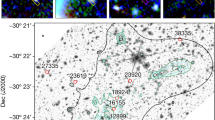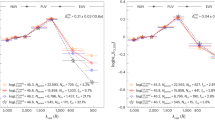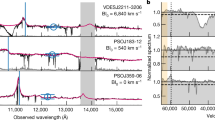Abstract
Cosmic (hydrogen) reionization marks one of the major phase transitions of the universe at redshift z ≥ 6. During this epoch, hydrogen atoms in the intergalactic medium were ionized by Lyman continuum (LyC) photons. However, it remains challenging to identify the major sources of the LyC photons responsible for reionization. In particular, individual contributions of quasars (or active galactic nuclei) and galaxies are still under debate. Here we construct the far-ultraviolet luminosity function for type 1 quasars at z ≥ 6 that spans 10 magnitudes (−19 ≤ MUV ≤ −29), conclusively showing that quasars made a negligible contribution to reionization. We mainly search for quasars in the low-luminosity range of MUV > −23 mag that is critical for determination of the total LyC photon production of quasars but has been barely explored previously. We find that the quasar population can only provide less than 7% (95% confidence level) of the total photons needed to keep the universe ionized at z = 6.0–6.6. Our result suggests that galaxies, presumably low-luminosity star-forming systems, are the major sources of hydrogen reionization.
This is a preview of subscription content, access via your institution
Access options
Access Nature and 54 other Nature Portfolio journals
Get Nature+, our best-value online-access subscription
$29.99 / 30 days
cancel any time
Subscribe to this journal
Receive 12 digital issues and online access to articles
$119.00 per year
only $9.92 per issue
Buy this article
- Purchase on Springer Link
- Instant access to full article PDF
Prices may be subject to local taxes which are calculated during checkout



Similar content being viewed by others
Data availability
All imaging data used in this paper are publicly available and the details are presented in Table 1 and Methods. Source data are provided with this paper.
Code availability
Data were reduced using publicly available data reduction pipelines.
References
Miralda-Escudé, J., Haehnelt, M. & Rees, M. J. Reionization of the inhomogeneous Universe. Astrophys. J. 530, 1–16 (2000).
Robertson, B. E., Ellis, R. S., Dunlop, J. S., McLure, R. J. & Stark, D. P. Early star-forming galaxies and the reionization of the Universe. Nature 468, 49–55 (2010).
Dayal, P. & Ferrara, A. Early galaxy formation and its large-scale effects. Phys. Rep. 780, 1–64 (2018).
Volonteri, M. & Gnedin, N. Y. Relative role of stars and quasars in cosmic reionization. Astrophys. J. 703, 2113–2117 (2009).
Onoue, M. et al. Minor contribution of quasars to ionizing photon budget at z ∼ 6: update on quasar luminosity function at the faint end with Subaru/Suprime-Cam. Astrophys. J. Lett. 847, 15–20 (2017).
Boutsia, K. et al. A high space density of L* active galactic nuclei at z ∼ 4 in the COSMOS field. Astrophys. J. 869, 20–26 (2018).
Giallongo, E. et al. Space densities and emissivities of active galactic nuclei at z > 4. Astrophys. J. 884, 19–52 (2019).
Kulkarni, G., Worseck, G. & Hennawi, J. F. Evolution of the AGN UV luminosity function from redshift 7.5. Mon. Not. R. Astron. Soc. 488, 1035–1065 (2019).
Finkelstein, S. L. et al. Conditions for Reionizing the Universe with a low galaxy ionizing photon escape fraction. Astrophys. J. 879, 36–69 (2019).
Grazian, A. et al. Lyman continuum escape fraction of faint galaxies at z~3.3 in the CANDELS/GOODS-North, EGS, and COSMOS fields with LBC. Astron. Astrophys. 602, 18 (2017).
Saxena, A. et al. No strong dependence of Lyman continuum leakage on physical properties of star-forming galaxies at 3.1≲ z ≲ 3.5. Mon. Not. R. Astron. Soc. 511, 120–138 (2022).
Aaron Yung, L. Y. et al. Semi-analytic forecasts for JWST – IV. Implications for cosmic reionization and LyC escape fraction. Mon. Not. R. Astron. Soc. 496, 4574–4592 (2020).
Joakim, R. et al. The SPHINX cosmological simulations of the first billion years: the impact of binary stars on reionization. Mon. Not. R. Astron. Soc. 479, 994–1016 (2018).
Willott, C. J. et al. The Canada–France high-z quasar survey: nine new quasars and the luminosity function at redshift 6. Astron. J. 139, 906–918 (2010).
Jiang, L. et al. The final SDSS high-redshift quasar sample of 52 quasars at z > 5.7. Astrophys. J. 833, 222–238 (2016).
Matsuoka, Y. et al. Subaru high-z exploration of low-luminosity quasars (SHELLQs). V. quasar luminosity function and contribution to cosmic reionization at z = 6. Astrophys. J. 869, 150–164 (2018).
Bañados, E. et al. The PAN-STARRS1 distant z > 5.6 quasar survey: more than 100 quasars within the first Gyr of the Universe. Astrophys. J. Suppl. 227, 11–37 (2016).
Kim, Y. et al. Discovery of a faint quasar at z ∼ 6 and implications for cosmic reionization. Astrophys. J. Lett. 813, 35–39 (2015).
Parsa, S., Dunlop, J. S. & McLure, R. J. No evidence for a significant AGN contribution to cosmic hydrogen reionization. Mon. Not. R. Astron. Soc. 474, 2904–2923 (2018).
Trebitsch, M. et al. The Obelisk simulation: Galaxies contribute more than AGN to HI reionization of protoclusters. Astron. Astrophys. 653, 154 (2021).
Grazian, A. et al. The space density of ultra-luminous QSOs at the end of reionization epoch by the QUBRICS Survey and the AGN contribution to the hydrogen ionizing background. Astrophys. J. 924, 62–72 (2022).
Giavalisco, M. et al. The Great Observatories Origins Deep Survey: Initial Results from Optical and Near-Infrared Imaging. Astrophys. J. Lett. 600, 93–98 (2004).
Scoville, N. et al. The Cosmic Evolution Survey (COSMOS): Overview. Astrophys. J. Suppl. 172, 1–8 (2007).
Aihara, H. et al. Third data release of the Hyper Suprime-Cam Subaru strategic program. Publ. Astron. Soc. Japan 74, 247–272 (2022).
McCracken, H. J. et al. UltraVISTA: a new ultra-deep near-infrared survey in COSMOS. Astron. Astrophys. 544, 156 (2012).
Koekemoer, A. M. et al. CANDELS: The Cosmic Assembly Near-infrared Deep Extragalactic Legacy Survey – The Hubble Space Telescope observations, imaging data products, and mosaic. Astrophys. J. Suppl. 197, 36–71 (2011).
Davis, M. et al. The All-Wavelength Extended Groth Strip International Survey (AEGIS) data sets. Astrophys. J. Lett. 660, 1–6 (2007).
Lawrence, A. et al. The UKIRT Infrared Deep Sky Survey (UKIDSS). Mon. Not. R. Astron. Soc. 379, 1599–1617 (2007).
Hans-Walter, R. et al. GEMS: galaxy evolution from morphologies and SEDs. Astrophys. J. Suppl. 152, 163–173 (2004).
Jarvis, M. J. et al. The VISTA Deep Extragalactic Observations (VIDEO) survey. Mon. Not. R. Astron. Soc. 428, 1281–1295 (2013).
Shen, Y. et al. Gemini GNIRS Near-infrared Spectroscopy of 50 Quasars at z ≳ 5.7. Astrophys. J. 873, 35–51 (2019).
Burrows, A., Sudarsky, D. & Lunine, J. I. Beyond the T Dwarfs: theoretical spectra, colors, and detectability of the coolest brown dwarfs. Astrophys. J. 596, 587–596 (2003).
Vanzella, E. et al. Spectroscopic observations of Lyman Break Galaxies at redshifts ~4, 5, and 6 in the Goods-South field. Astrophys. J. 695, 1163–1182 (2009).
Stark, D., Ellis, R. S. & Ouchi, M. Keck spectroscopy of faint 3 > z > 7 Lyman break galaxies: a high fraction of line emitters at redshift six. Astrophys. J. Lett. 728, 2–6 (2011).
Pentericci, L. et al. CANDELSz7: a large spectroscopic survey of CANDELS galaxies in the reionization epoch. Astron. Astrophys. 619, 147 (2018).
Luo, B. et al. The Chandra Deep Field-South survey: 7 Ms source catalogs. Astrophys. J. Suppl. 228, 2–31 (2017).
Marshall, M. A. et al. The host galaxies of z = 7 quasars: predictions from the BLUETIDES simulation. Mon. Not. R. Astron. Soc. 499, 3819–3836 (2020).
Lupi, A. et al. High-redshift quasars and their host galaxies - II. Multiphase gas and stellar kinematics. Mon. Not. R. Astron. Soc. 510, 5760–5779 (2022).
Mechtley, M. et al. Near-infrared imaging of a z = 6.42 quasar host galaxy with the Hubble Space Telescope Wide Field Camera 3. Astrophys. J. Lett. 756, 38–43 (2012).
Jiang, L. et al. A Magellan M2FS spectroscopic survey of galaxies at 5.5 < z < 6.8: program overview and a sample of the brightest Lyα emitters. Astrophys. J. 846, 134–148 (2017).
Jiang, L. et al. Keck spectroscopy of Lyman-break galaxies and its implications for the UV-continuum and Lyα luminosity functions at z > 6. Astrophys. J. 743, 65–74 (2011).
Gehrels, N. Confidence limits for small numbers of events in astrophysical data. Astrophys. J. 303, 336–346 (1986).
Ren, K. & Trenti, M. A physical model for the quasar luminosity function evolution between cosmic dawn and high noon. Astrophys. J. 923, 110–118 (2021).
Shen, X. et al. The bolometric quasar luminosity function at z = 0–7. Mon. Not. R. Astron. Soc. 495, 3252–3275 (2020).
Cristiani, S. et al. The spectral slope and escape fraction of bright quasars at z ∼ 3.8: the contribution to the cosmic UV background. Mon. Not. R. Astron. Soc. 462, 2478–2485 (2016).
Lusso, E. et al. The first ultraviolet quasar-stacked spectrum at z ≃ 2.4 fromWFC3. Mon. Not. R. Astron. Soc. 449, 4204–4220 (2015).
Madau, P., Haardt, F. & Rees, M. J. Radiative transfer in a clumpy universe. III. the nature of cosmological ionizing sources. Astrophys. J. 514, 648–659 (1999).
Finlator, K., Oh, S. P., Özel, F. & Davé, R. Gas clumping in self-consistent reionization models. Mon. Not. R. Astron. Soc. 427, 2464–2479 (2012).
Iwata, I. et al. Ionizing radiation from AGNs at z > 3.3 with the Subaru Hyper Suprime-Cam Survey and the CFHT Large Area U-band Deep Survey (CL AUDS). Mon. Not. R. Astron. Soc. 509, 1820–1836 (2022).
Zeltyn, G. & Trakhtenbrot, B. The contribution of AGN accretion disks to hydrogen reionization. Astrophys. J. 929, 21 (2022).
Zhan, H. The wide-field multiband imaging and slitless spectroscopy survey to be carried out by the Survey Space Telescope of China Manned Space Program. Chin. Sci. Bull. 66, 1290–1298 (2021).
Becker, G. D. et al. The mean free path of ionizing photons at 5 < z < 6: evidence for rapid evolution near reionization. Mon. Not. R. Astron. Soc. 508, 1853–1869 (2021).
Davies, F. B. et al. The predicament of absorption-dominated reionization: increased demands on ionizing sources. Astrophys. J. Lett. 918, 35–41 (2021).
Willott, C. J. et al. Four quasars above redshift 6 discovered by the Canada-France High-z Quasar survey. Astron. J. 134, 2435–2450 (2007).
Willott, C. J. et al. Six more quasars at redshift 6 discovered by the Canada-France High-z Quasar survey. Astron. J. 137, 3541–3547 (2009).
Jiang, L. et al. Physical properties of spectroscopically confirmed galaxies at z ≥ 6. II. morphology of the rest-frame UV continuum and Lyα emission. Astrophys. J. 773, 153–166 (2013).
Bertin, E. & Arnouts, S. SExtractor: software for source extraction. Astron. Astrophys Suppl. 117, 393–404 (1996).
Ning, Y. et al. The Magellan M2FS spectroscopic survey of high-redshift galaxies: a sample of 260 Lyα emitters at redshift z ≈ 5.7. Astrophys. J. 903, 4–16 (2020).
Ning, Y., Jiang, L., Zheng, Z.-Y. & Wu, J. The Magellan M2FS spectroscopic survey of high-redshift galaxies: Ly𝛼 emitters and luminosity function at redshift 6.6. Astrophys. J. 926, 230–243 (2020).
Moster, B. P., Somerville, R. S., Newman, J. A. & Rix, H.-W. A cosmic variance cookbook. Astrophys. J. 731, 113–120 (2011).
Bhowmick, A. K. et al. Cosmic variance of z > 7 galaxies: prediction from BLUETIDES. Mon. Not. R. Astron. Soc. 496, 754–766 (2020).
Acknowledgements
L.J., Y.N., L.H., J.W. and X.W. acknowledge support from the National Science Foundation of China (grant nos. 11721303, 11890693 and 12022303) and the China Manned Space Project (grant nos. CMS-CSST-2021-A04, CMS-CSST-2021-A05 and CMS-CSST-2021-A06). This Article used observations made with the NASA/ESA Hubble Space Telescope, and obtained from the Hubble Legacy Archive, which is a collaboration between the Space Telescope Science Institute (STScI/NASA), the Space Telescope European Coordinating Facility (ST-ECF/ESA) and the Canadian Astronomy Data Centre (CADC/NRC/CSA).
Author information
Authors and Affiliations
Contributions
L.J. designed the program, analyzed the data, and prepared the manuscript. Y.N. and J.W. performed the image simulations. X.F. and L.H. helped to prepare the manuscript. B.L. and Z.Z. helped with the calculation of the QLF. F.W., X.W and J.Y. helped with the quasar selection. All authors helped with the scientific interpretations and commented on the manuscript.
Corresponding author
Ethics declarations
Competing interests
The authors declare that they have no competing interests.
Peer review
Peer review information
Nature Astronomy thanks James Dunlop and the other, anonymous, reviewer(s) for their contribution to the peer review of this work.
Additional information
Publisher’s note Springer Nature remains neutral with regard to jurisdictional claims in published maps and institutional affiliations.
Extended data
Extended Data Fig. 1 The z–J versus i–z color-color diagram of high-redshift quasars for different filter sets.
The red, green, and blue circles show the median tracks of the quasar colors calculated for the GOODS, COSMOS, and EGS fields, respectively. The starting redshift is 5.8 and the step size is 0.1. The ending redshifts are different for different fields. The filled circles represent the redshift ranges that we used for target selection.
Extended Data Fig. 2 Color selection completeness maps.
The contours are selection probabilities from 0.8 to 0.2 with an interval of 0.2 for four fields.
Source data
Source Data Fig. 1
Source data for Fig. 1.
Source Data Fig. 2
Source data for Fig. 2.
Source Data Fig. 3
Source data for Fig. 3.
Source Data Extended Data Fig. 1
Source data for Extended Data Fig. 1.
Source Data Extended Data Fig. 2
Source data for Extended Data Fig. 2.
Rights and permissions
About this article
Cite this article
Jiang, L., Ning, Y., Fan, X. et al. Definitive upper bound on the negligible contribution of quasars to cosmic reionization. Nat Astron 6, 850–856 (2022). https://doi.org/10.1038/s41550-022-01708-w
Received:
Accepted:
Published:
Issue Date:
DOI: https://doi.org/10.1038/s41550-022-01708-w



